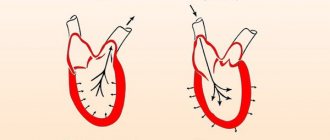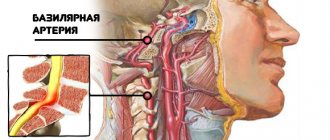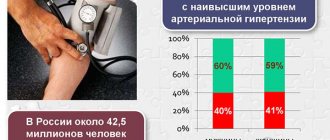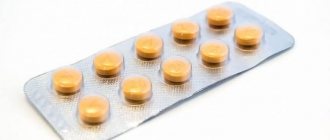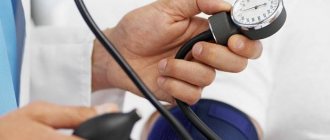Pressure in the generally accepted sense refers to the force with which the blood presses on the great vessels. In most cases, this indicator is sufficient to determine the quality of health in general and the state of the cardiovascular system in particular.
There are blood pressure standards adopted by the World Health Organization for adult patients. They are defined by the range from 100 to 140 mmHg at 60-90. It reflects the individual norms of individual patients.
It is necessary to make a reservation: the individual norm can be 10 mmHg higher or lower than the accepted one, this also does not pose a danger. In all other cases we are talking about pathologies of varying degrees of severity.
When assessing the blood pressure level, you need to decide on what border it is located. Above 140 over 90 is hypertension or hypertension (not a disease, but a condition), below 100 over 60 is hypotension.
What option should we talk about: normal or pathological if the tonometer shows a pressure of 140 over 80 or figures close to it: 140 over 75, 145 over 80? In this case, the working pressure of a particular person is taken into account.
If the patient’s normal indicator is on the border of 100-120 per 80 or slightly lower, this is hypertension. Otherwise, we can talk about a variant of the clinical norm.
Is blood pressure normal at 140 over 80?
If you follow the recommendations of the World Health Organization, yes, quite normal. But it is necessary to take into account the individual characteristics of a particular patient’s body. Figures divorced from life in such a situation say little.
It is important to start from several factors at once, assessing them as a whole: age, gender, health status, the presence or absence of somatic diseases, the use of certain medications, body type, professional activity.
Age
It does not play a primary role, but it determines pressure in many cases. So, in a teenager, an increase in the tonometer reading to 140 to 80 mmHg is normal.
A hormonal storm is raging in the body of a young man or girl, vascular tone is rapidly changing, and an attack of hypotension is followed by an increase in blood pressure.
This is a temporary phenomenon, you need to wait it out. However, if the tonometer readings continue to rise, especially if by the end of puberty (puberty) the blood pressure level does not stabilize, this is a reason to go to the doctor. Perhaps the problem lies much deeper.
Older patients are also more likely to develop hypertension. The burden of diseases accumulated over a lifetime affects the overall vascular tone. Pathological changes are especially noticeable in chronic smokers and people suffering from alcoholism.
Thus, in older adults and adolescents, an increase in blood pressure to these levels is possible and often occurs as a variant of the clinical norm.
Floor
Representatives of the fairer sex are more susceptible to developing hypertension.
Paradoxically, heart attacks and strokes more often occur in men, despite the ratio of hypertensive patients not in their favor. This is not an axiom, but a common occurrence.
Peak hormonal conditions that are not pathological:
These include pregnancy, menopause, puberty (already mentioned) and the menstrual cycle.
Attention:
During pregnancy, blood pressure often drops, bradycardia (decreased heart rate) is observed; if blood pressure increases, you need to look for the cause.
The menstrual cycle is always associated with hormonal fluctuations. Options are possible: a drop in blood pressure or its increase, it all depends on the characteristics of the patient’s body.
Menopause is accompanied by a decrease in specific active substances in the female body. Therefore, hypertension with sharp jumps in blood pressure up to levels of 140 to 80 and above is a common occurrence in women from 45 to 55 years old. This condition is corrected under the supervision of a competent cardiologist.
Taking medications
An increase in blood pressure is possible when taking anti-inflammatory drugs, corticosteroids and some other medications that increase vascular tone and retain fluid in the body.
It is also possible for the so-called withdrawal syndrome to develop: when the patient abruptly stops taking antihypertensive drugs.
In such a situation, a tonometer reading of 140 to 80 mmHg is the least that can happen. A hypertensive crisis is likely.
Physique and professional activity
The larger the patient, the higher his body weight, the more likely the development of hypertension. Persistent, chronic increases in blood pressure are typical for athletes and manual workers.
These are the basic physiological factors that do not require specific treatment. Pathological causes carry a much greater danger.
Contraindications for hypertension
Headache with hypertension has its own characteristics. To get rid of it, it is necessary to relax the vascular walls and cause their expansion, as well as stimulate the outflow of excess fluid. At home, it is prohibited to take the following measures to treat pain caused by increased blood pressure:
- be in a stuffy room;
- take a hot bath, visit a bathhouse or sauna;
- drink coffee or natural strong tea, which also contains high concentrations of caffeine;
- buy or drink alcoholic beverages.
It is important to understand that treatment tactics and first aid differ for high and low blood pressure. Before taking medications, you must use a tonometer, and then periodically monitor the readings. It is especially important to monitor them in case of vegetative-vascular dystonia, a chronic disease in which blood pressure periodically changes both up and down.
Pathological factors of pressure deviation from normal
A blood pressure of 140 over 80 is not normal in some cases. The reasons for this may be pathological. What diseases most often cause the onset of hypertension?
Endocrine disorders
They are diverse in nature and localization of the primary process:
- Itsenko-Cushing's disease or hypercortisolism. Develops as a result of disruption of the production of corticotropin by the anterior pituitary gland. The more hormone is produced, the more significant the tonometer readings are. Primary hypercortisolism is possible as a result of the course of tumors and injuries to the adrenal glands themselves, previous operations.
- Hyperthyroidism. In other words, increased production of thyroid hormones. In high concentrations they produce a toxic effect on the entire body. The body begins to work for wear. The pressure increases significantly, and regular hypertensive crises are observed.
- Diabetes. It affects all organs and systems, including the cardiovascular and endocrine systems. Requires urgent medication correction or diet if the cause is obesity.
Other diseases
- Pathologies associated with cerebral circulation disorders. Including vertebrobasilar insufficiency, etc., the trophism of special regulatory centers of the brain is disrupted. Vessels cannot adequately respond to dynamic changes in the body.
- Kidney pathologies. A pressure of 138-140 to 80-85 may mean the initial stage of pyelonephritis, glomerulonephritis, nephritis, renal failure, nephropathy. All diseases are associated with a high risk of developing secondary hypertension as the process progresses.
- Atherosclerosis of the aorta, blood vessels, and brain structures. There are two types: stenosis (narrowing) or blockage. In any case, the lumen of the vessel narrows, an increase in blood pressure occurs, and the blood has to overcome greater resistance.
Also, the reasons for a regular increase in indicators can be subjective: alcohol abuse, smoking, excessive consumption of salt and salty foods, physical inactivity, improper drinking regimen.
What does a fast or slow pulse indicate?
Heart rate values may vary, but they do not indicate any particular disease, but only the etiology of the process.
It is necessary to evaluate the blood pressure indicator, only secondarily look to see if there is tachycardia (pulse more than 80 beats per minute) or bradycardia (less than 60 beats per minute).
When the heart rate increases, the cause is sought in the heart, blood vessels, endocrine pathologies and kidneys, and when it decreases, the cause is found in the anemic process (iron deficiency) and cerebrovascular accidents.
What can you take at home?
If objective diagnostics confirm that a reading of 140 to 80 is normal for a particular patient, nothing needs to be done. It will only get worse.
In case of proven hypertension, taking medications on your own is completely contraindicated. Absolutely all emergency antihypertensive drugs have pronounced activity and sharply lower blood pressure.
The consequences of such amateur activity can and will be disastrous. Per hour, you can reduce the pressure by no more than 40-60 mmHg. Precise dosing of such medications is required, which is the responsibility of a cardiologist.
Self-medication is not an adequate option. If the patient does not feel well, you need to call an ambulance or, at the first opportunity, contact a cardiologist for a thorough diagnosis.
Before the ambulance arrives, you need to take a horizontal position, calm down, you can drink Valocordin, motherwort or valerian tablets. These are mild sedatives that gently lower blood pressure levels. The doctors will do the rest.
Classification by degree
Indicators of vascular hypertonicity are classified as follows:
- normal pressure: 120-129 at 80-84 mmHg. Art.;
- normal increased: 130-139 mm Hg. Art. systolic, 85-89 mm Hg. st diastolic;
- 1st degree of arterial hypertension: slight increase in numbers - from 140/90 to 159/99 mm Hg. Art.;
- 2nd degree: moderate increase - 160/100-179/109 mm Hg. Art.;
- Grade 3: high blood pressure over 180/110 mmHg. Art.;
- isolated systolic hypertension: systolic pressure above 140 mm Hg. Art., diastolic - less than 90 mm Hg. Art.
Symptoms requiring consultation with a specialist
The main manifestations that require therapeutic intervention in a planned manner are the following:
- Headache. Usually of a sharp, stabbing, shooting nature. Pulsates in time with the beat of the heart. It may feel like being hit on the head with a hammer. This is a dangerous manifestation. It is quite possible to develop a stroke.
- Dizziness. Due to local circulatory disorders in cerebral structures. The cerebellum is primarily affected.
- Visual impairment: photopsia, spots before the eyes. Indicates the involvement of the retinal vessels in the process.
- Weakness, drowsiness. It is caused by insufficient blood circulation in the brain and hemodynamic disturbances.
Prevention methods
Most patients are diagnosed with acquired hypertension. This means that timely prevention will help avoid its occurrence and strengthen blood vessels. At home you need to follow simple rules:
- provide daily moderate exercise;
- spend time outdoors;
- control weight, prevent the development of obesity;
- follow the principles of proper nutrition;
- to refuse from bad habits.
The Clinical Brain Institute offers individual programs for diagnosing and treating headaches caused by high blood pressure. Here you can get competent advice from doctors, undergo a full examination and monitor the dynamics of the development of the disease. Hypertension is not dangerous if you follow the recommendations, take medications on time and avoid situations that provoke increased blood pressure.
How is constant pressure of 140 over 80 treated?
Regular or constant pressure of 140 over 80 in an adult, for whom such indicators of the device are not considered normal, is treated with different methods, depending on the primary pathology.
The basis of therapy is the fight against the root cause. These may be diseases of the kidneys, cerebral structures, heart and blood vessels. The general treatment plan includes the prescription of drugs from the following pharmaceutical groups:
- ACE inhibitors.
- Diuretics (diuretics, but with great caution, you can “plant” the kidneys).
- Calcium channel blockers.
- Beta blockers.
It is possible to prescribe other drugs. For proven vegetative disorders, the use of light sedatives based on herbal components is indicated.
For emergency help, medications like Capoten are used.
Barbiturates are also used in minimal dosages. They have a calming effect. These are mandatory conditions for treatment.
Atherosclerotic plaques are eliminated by taking special medications. Calcified lesions may require surgery (a relatively rare occurrence).

